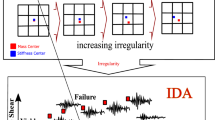Abstract
The multi-pulse near-fault earthquake motion imposes unique influence on the seismic risk for bridge structure. Regarding the different character of multiple pulse-like waveforms embedded in the near-fault seismic signal, the mother wavelet in wavelet analysis should be adaptively selected for best representation of the embedded multi-pulse seismic signal. A novel adaptive mother wavelet selection procedure is proposed to identify the optimum mother wavelet for each dominant pulse. The seismic risk for the example bridge system is analyzed by incremental dynamic analysis. The result indicates that the identified most unfavorable seismic signal dominates the bridge system fragility compared with the recorded horizontal signals. The top and bottom boundary of the expected annual loss ratio of the unfavorable seismic signal is 4.67% and 6.22% larger than the average value of recorded horizontal signals, respectively. It is necessary to consider the influence of the identified unfavorable seismic signal on the seismic risk for the bridge system compared with the recorded horizontal seismic signals.



















Similar content being viewed by others
References
Al Atik L, Abrahamson N (2010) An improved method for nonstationary spectral matching. Earthq Spectra 26(3):601–617
Alavi B, Krawinkler H (2000) Consideration of near-fault ground motion effects in seismic design. In: Proceedings of the 12th world conference on earthquake engineering, New Zealand
Association JR (2002) Design specifications for highway bridges: part V. Seismic Design, Tokyo
Baker JW (2007) Quantitative classification of near-fault ground motions using wavelet analysis. Bull Seismol Soc Am 97(5):1486–1501
Billah A, Alam MS (2015) Seismic fragility assessment of highway bridges: a state-of-the-art review. Struct Infrastruct Eng 11(6):804–832
Buckle IG, Friedlnd I, Mander J et al (2006) Seismic retrofitting manual for highway structures: part 1-bridges. Federal Emergency Management Agency, Washington
CALTRANS (2013) Seismic design criteria version 1.7
Cornell CA (1968) Engineering seismic risk analysis. Bull Seismol Soc Am 58(5):1583–1606
Gao XW, Bao AB (1985) Probabilistic model and its statistical parameters for seismic load. Earthq Eng Eng Dyn 5(1):13–22
Ghaffarzadeh H (2016) A classification method for pulse-like ground motions based on S-transform. Nat Hazards 84(1):335–350
Hwang H, Liu JB, Chiu Y-H (2001) Seismic fragility analysis of highway bridges. Mid-America Earthquake Center, Urbana
Iyama J, Kuwamura H (1999) Application of wavelets to analysis and simulation of earthquake motions. Earthq Eng Struct Dyn 28(3):255–272
Li C, Hao H, Li H et al (2016) Seismic fragility analysis of reinforced concrete bridges with chloride induced corrosion subjected to spatially varying ground motions. Int J Struct Stab Dyn 16(05):1550010
Lu Y, Panagiotou M (2014) Characterization and representation of near-fault ground motions using cumulative pulse extraction with wavelet analysis. Bull Seismol Soc Am 104(1):410–426
Mander JB, Dhakal RP, Mashiko N et al (2007) Incremental dynamic analysis applied to seismic financial risk assessment of bridges. Eng Struct 29(10):2662–2672
Mavroeidis GP, Papageorgiou AS (2003) A mathematical representation of near-fault ground motions. Bull Seismol Soc Am 93(3):1099–1131
Mazzoni S, McKenna F, Scott MH et al (2003) OpenSEES users comman manual: PEER. University of California, Berkeley
Mollaioli F, Bruno S, Decanini LD et al (2006) Characterization of the dynamic response of structures to damaging pulse-type near-fault ground motions. Meccanica 41(1):23–46
Ngui WK, Leong MS, Hee LM et al (2013) Wavelet analysis: mother wavelet selection methods. Appl Mech Mater 393:953–958
Panella DS, Tornello ME, Frau CD (2017) A simple and intuitive procedure to identify pulse-like ground motions. Soil Dyn Earthq Eng 94(Supplement C):234–243
Sciences, N. I. o. B. (2003) HAZUS MR4 Technical manual, Washington, DC
Sehhati R, Rodriguez-Marek A, ElGawady M et al (2011) Effects of near-fault ground motions and equivalent pulses on multi-story structures. Eng Struct 33(3):767–779
Sengupta A, Quadery L, Sarkar S et al (2016) Influence of bidirectional near-fault excitations on RC bridge piers. J Bridge Eng 21(7):04016034
Somerville PG, Smith NF, Graves RW et al (1997) Modification of empirical strong ground motion attenuation relations to include the amplitude and duration effects of rupture directivity. Seismol Res Lett 68(1):199–222
Xu Z, Agrawal A (2010) Decomposition and effects of pulse components in near-field ground motions. J Struct Eng ASCE 136(6):690–699
Ye LP, Ma QL, Miao ZW (2009) Study on earthquake intensities for seismic analysis for structures. Earthq Eng Eng Dyn 29(04):9–22
Zhai CH, Chang ZW, Li S et al (2013) Quantitative identification of near-fault pulse-like ground motions based on energy. Bull Seismol Soc Am 103(5):2591–2603
Zhao GC, Xu LJ, Xie LL (2016) A simple and quantitative algorithm for identifying pulse-like ground motions based on zero velocity point method. Bull Seismol Soc Am 106(3):1011–1023
Author information
Authors and Affiliations
Corresponding author
Ethics declarations
Conflict of interest
The authors declared that they have no conflict of interest.
Additional information
Publisher's Note
Springer Nature remains neutral with regard to jurisdictional claims in published maps and institutional affiliations.
Rights and permissions
About this article
Cite this article
Xia, C., Liu, C. Influence of the multi-pulse near-fault earthquake motion on the seismic risk evaluation for reinforced concrete bridge. Nat Hazards 102, 759–782 (2020). https://doi.org/10.1007/s11069-019-03840-9
Received:
Accepted:
Published:
Issue Date:
DOI: https://doi.org/10.1007/s11069-019-03840-9




